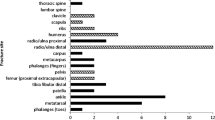Abstract:
A measurement of bone mass is the single most important determinant of future fracture. However, controversy exists as to which technique (dual X-ray absorptiometry (DXA) or peripheral quanitative computed tomography (pQCT)), and which site of skeletal measurement (axial vs appendicular) provides the best prediction of fracture risk. The aims of this study were: (1) to determine the ability of pQCT to predict bone mass of the lumbar spine, proximal femur, and distal forearm measured using DXA, and (2) to compare the ability of DXA and pQCT to discriminate prevalent fractures in women with established osteoporosis. One hundred and sixty-five women were studied, including 47 with established osteoporosis (vertebral, hip or Colles' fractures) as well as 118 who had bone mass measurements to assess osteoporosis risk. Each subject had bone mass measured by DXA at the lumbar spine and femoral neck, and at the distal radius by both DXA and pQCT. In women with fractures, bone mass, when expressed as a standardized score, was in general lower using DXA compared with the appendicular skeleton measured using pQCT. Bone mass determinations at all sites were significantly correlated with each other. The highest correlation coefficients were observed within the axial skeleton. In women with fractures, the highest odds ratios were observed at skeletal regions measured using DXA. Likewise, the areas under the receiver-operating characteristic (ROC) curves were comparable at all skeletal regions measured using DXA; and were significantly greater than the areas under the ROC curves for pQCT measurements. In summary, the strongest discriminators of prevalent fractures were measurements using DXA. Measurements of bone mass at the appendicular skeleton, using either DXA or pQCT, were poorly associated with axial bone mass. PQCT has the poorer ability to discriminate persons with fractures, and appears to be less sensitive than measurements using DXA.
Similar content being viewed by others
Author information
Authors and Affiliations
Additional information
Received: 15 September 1997 / Accepted: 17 February 1998
Rights and permissions
About this article
Cite this article
Formica, C., Nieves, J., Cosman, F. et al. Comparative Assessment of Bone Mineral Measurements Using Dual X-ray Absorptiometry and Peripheral Quantitative Computed Tomography. Osteoporos Int 8, 460–467 (1998). https://doi.org/10.1007/s001980050092
Issue Date:
DOI: https://doi.org/10.1007/s001980050092




